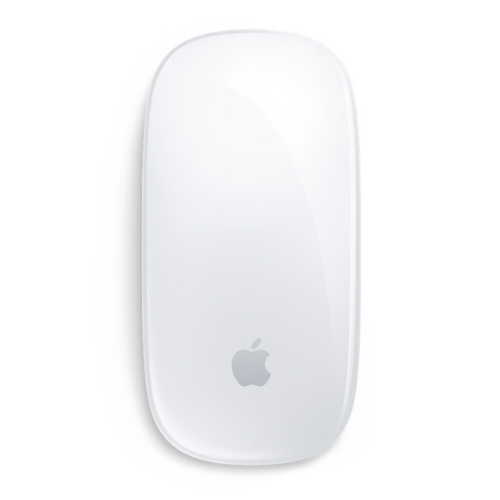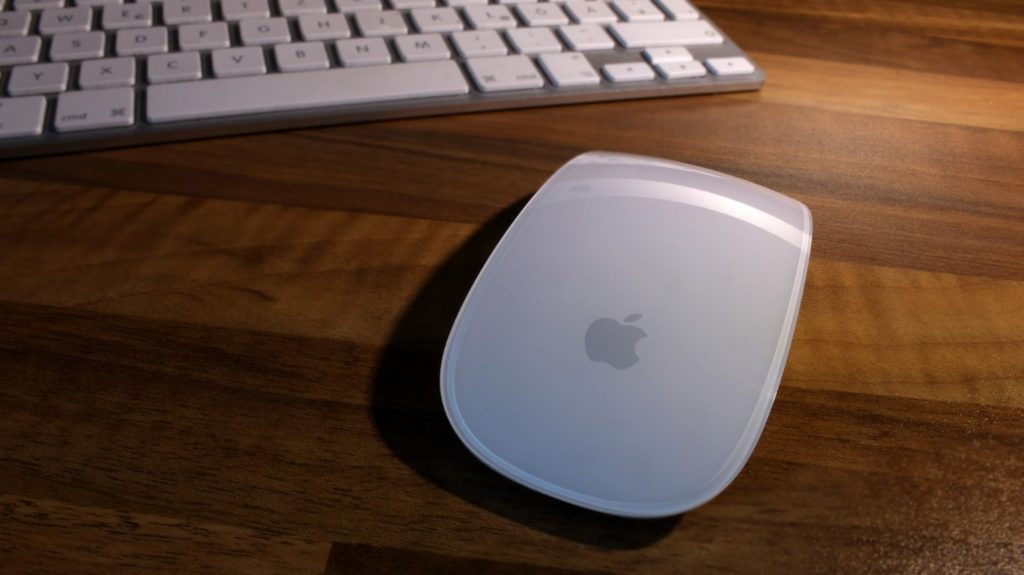Despite all the urban legends, Steve Jobs didn’t invent the computer mouse (you can learn more about the history here). But he was responsible for popularizing them. During his tenure at Apple, Jobs helped develop and launch countless iterations of computer mice, culminating in what some argue was the most innovative peripheral of its era — the original Magic Mouse.
The original Magic Mouse was revolutionary, incorporating a Broadcom Bluetooth chipset, an enhanced laser sensor, and never-before-seen gesture controls. But Jobs knew that technology moves quickly, and you have to continue innovating or get left behind. Tragically, he died shortly after the mouse’s release, taking his knowledge and magic with him.
The company just updated the Magic Mouse for 2022, and it still retains the same shell and basic functionality as the original 12-year-old model. In this Magic Mouse review, I’ll show you what happened and where Apple went wrong.
Magic Mouse Pros & Cons
- Sleek, uniform shell is completely ambidextrous
- Tactile mechanical button provides vital sensory feedback
- Gains 30 days of battery life on a single 3-hour charge
- Portable, low-profile shell slips in your bag for easy transport
- Updated 2022 variant includes few new features
- Charges via an outdated Lightning port
- Charging port is on the bottom of the mouse
- Long, strip-like mouse feet glide poorly

- Price: $79
- Maximum DPI: 1,300
- Connectivity: Wireless
- Buttons: 1
- Weight: 100 grams
- Best for: macOS and iPadOS users
- Warranty: 1 Year
- Return Period: 14 Days
- Shipping: Free
- Connects to your macOS and iPadOS devices via Bluetooth and USB-C
- Apple’s laser sensor features a 90 Hz report rate and tracks at a reasonable 1,300 DPI
- Multi-Touch surface supports gesture controls, including swiping and scrolling down pages
Learn more about the Magic Mouse from these online retailers.
How Well Does the Magic Mouse Perform?

Although the Magic Mouse has undoubtedly lost much of its magic, the iconic peripheral still has some redeeming qualities. The laser sensor is highly accurate on most surfaces, the ambidextrous design is exceptionally accessible, and the mouse incorporates that sweet silvery-white Apple aesthetic. But even with these features in mind, the Magic Mouse still feels like an outdated peripheral.
In the following sections of the Magic Mouse review, I’ll break down its performance under several vital categories. Let’s start by looking at a mouse’s most important quality: its responsiveness & tracking.
Responsiveness & Tracking
The Magic Mouse syncs with your Mac or iPad like a wand to its wizard. Simply take it out of the box, turn on Bluetooth pairing, and your Apple device will recognize it near-instantaneously. More importantly, the Magic Mouse is extraordinarily reliable, never skipping out or losing connection while paired.
Unfortunately, the Bluetooth connection is more tortoise than hare. Although you shouldn’t have problems with web browsing or general software applications, the 90 Hz report rate is much slower than the industry-standard 125 Hz. While this may seem inconsequential, the Magic Mouse ends up with a 40ms response time from click to on-screen action. It’s a definite no-go for gaming, and I’d even hesitate to recommend the 40ms response time to illustrators and designers who expect their creations to come alive with each stroke.
Fortunately, cursor movement is quite accurate, and it moves at a fairly reasonable 1,300 DPI (dots per inch). While this is a little sluggish for my liking, most users should find it fast enough for everyday tasks and slow enough to offer reasonable control over cursor placement. If you need to go slower (you probably don’t), you can also adjust it via Apple’s built-in mouse settings panel.
Lastly, there are Apple’s Multi-Touch controls. While the nature of this technology leads to some inevitable delay, I’m still a massive fan. Mouse gesturing feels intuitive, effective, and lots of fun. Use your fingers to scroll down pages or swap between windows with a single swipe. For a complete list of Multi-Touch controls, check out this official resource.
Comfort & Ergonomics
Although I’m a minimalist, comfort and ergonomic functionality come before aesthetic design. Sadly, it seems like the R&D folks at Apple placed all their emphasis on simplicity without a second thought for comfort or ergonomics. There’s no thumb or pinky support, and you can’t even rest your palm on the mouse, or your fingers end up dangling over the front edge. Instead, you’ll need to rely on a fingertip grip, which is far from comfortable for most users.
But it’s not all bad news. I love how the small frame supports all hand sizes, small to large. What’s more, the mouse’s unique one-button design is fully ambidextrous, providing a suitable foundation for lefties and righties alike. Clicking on the center button also provides excellent spring for better responsiveness and sensory feedback.
While I typically prefer a slightly textured surface — even a matte plastic — I do enjoy the Magic Mouse’s acrylic top. It feels buttery-smooth to the touch and provides a lovely surface for resting your fingertips or gesturing around your desktop. Grip is an issue, however. Your only option is to grab the Magic Mouse by its sides, pressing your fingers into the minuscule gap between the acrylic surface and aluminum undershell. It may go without saying, but this is extraordinarily uncomfortable for extended work sessions.
Construction & Design

Apple and its manufacturing partner, Foxconn, did an excellent job building a robust, pro-grade mouse. Shatter-proof acrylic and sturdy aluminum have never looked so good, and the silvery-white tone blends well with the entire Apple ecosystem. It’s the ideal pairing for your new M1 Macbook or iPad.
The Magic Mouse’s durability and slim profile also make it excellent for travel. In fact, I’d argue that the Magic Mouse is among the best travel mice on the market. It’s easy to slip in a bag and take on the commuter train or slip out once you get to work.
Unfortunately, there are a couple of problems with the design. Although the Magic Mouse has been rechargeable ever since the 2016 update, it still incorporates a Lightning charge port — an outdated standard, easily bested by USB-C. Even more problematic, the charging port is on the bottom of the mouse! Yes, you have to flip the mouse upside down to charge it, meaning you’ll need to stop and break from your activities every time it runs out of juice.
The mouse’s feet are another big problem. The Magic Mouse features two long plastic skates to glide around on — yet it hobbles more than it glides. These plastic skates are among the worst I’ve experienced, and I can’t believe that Apple hasn’t updated these awful feet.
Our Verdict of the Magic Mouse
The original Magic Mouse was a game-changer. It came to fruition back when most mice were still tethered by wires, and the simple design offered an ideal solution just as everything was becoming more portable. But it’s not 2009 anymore.
We’re in the 2020s now, yet Apple has hardly changed a thing on the Magic Mouse. The biggest update in 12 years was moving from AA batteries to a rechargeable one. While I can’t knock Apple’s commitment to a more sustainable design philosophy, that’s hardly even an upgrade.

Although accurate, the Magic Mouse’s 90 Hz report rate and 40ms response times are a joke. To put it in perspective, 40ms is double that of SitWorkPlay’s favorite wireless mouse, the Logitech MX Master 3. Instead of innovating, Apple is trailing the competition from a mile behind.
The Magic Mouse also suffers from a lack of comfort and ergonomics. Although I applaud the ambidextrous design and lovely tactile button, Apple gets nearly everything else wrong. You have to hold onto the mouse with just your fingertips, and there’s no thumb or pinky ledge for extra support.
Now, don’t get me wrong: I love how the Magic Mouse looks. The classy aesthetic is quintessential Apple. It’s also built like a tank, providing a pleasant juxtaposition to the slim frame. But even here, the design is hindered by an absurd under-side charging port. Meanwhile, the appalling mouse feet feel more like a tank trudging through a minefield than a business-oriented peripheral that should zip around with glee.
Despite my harsh criticism in this Magic Mouse review, the Magic Mouse isn’t terrible. I could see myself using it on trips or whipping it out to impress clients with my suave Apple gear. It also works exceptionally well with macOS and iPadOS, connecting in a heartbeat and offering continuous connectivity that rarely misses a beat. But this is Apple we’re talking about, for goodness sakes! I expect more from the company responsible for popularizing the mouse in the first place.
Other Models from Apple
- Magic Trackpad | Amazon ($129) – If you prefer a laptop-inspired trackpad to a traditional mouse, the Multi-Touch Magic Trackpad makes it easy to move around your macOS desktop.
Comparable Mice from Other Brands
- Logitech MX Master 3 | Amazon ($99.99) – Tracking and ergonomics are critical to a mouse’s performance, and Logitech MX Master 3 is as snappy and comfortable as they come.
- Microsoft Arc Mouse | Amazon ($65.49) – The Microsoft Arc is similar to the Magic Mouse in form and function, but it works well on macOS and Windows devices.
- Logitech Pebble M350 | Amazon ($29.99) – For those seeking portability without the price tag, Logitech’s Pebble M350 offers a slim form factor with Bluetooth capabilities and enhanced ergonomics.
Should You Buy The Magic Mouse?
Like I said in SitWorkPlay’s Magic Keyboard review, Apple’s gear always syncs and performs flawlessly within its own ecosystem. If you swear by Apple’s products, you’ll enjoy the Magic Mouse’s low-profile design, overall accuracy, and excellent battery life. You may be a little disappointed by the sluggishness, but it should get the job done, nonetheless.
If you’re not a hardcore Apple enthusiast, I encourage you to stay away. Although grand in its heyday, the Magic Mouse’s tracking, comfort, and construction suffer from frustrating and outdated elements. Nowadays, there are much better options at a similar price. Take a look at the Logitech MX Master 3 for top-tier performance under $100, or visit our page on the best wireless mice for all of today’s top options. You can also check out our post on wired and wireless mice to get an idea of the pros and cons of each type.
Subscribe To SitWorkPlay
Email Sign-Up
"*" indicates required fields

